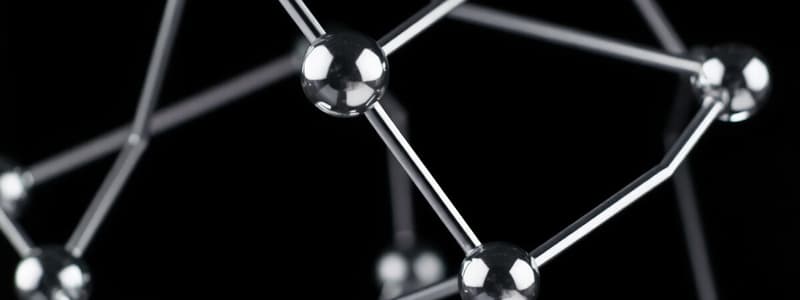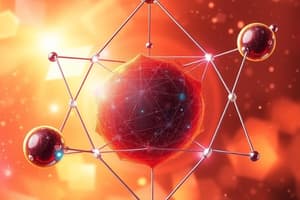Podcast
Questions and Answers
What primarily determines the molecular geometry of a molecule?
What primarily determines the molecular geometry of a molecule?
- The molecular weight of the compound
- The number of lone pairs and bonding pairs on the central atom (correct)
- The type of elements involved in the bonding
- The temperature and pressure conditions
How does VSEPR theory help in predicting molecular shapes?
How does VSEPR theory help in predicting molecular shapes?
- By arranging electron pairs as far apart as possible to minimize repulsion (correct)
- By calculating the angles between bonds
- By minimizing the distance between nuclei of bonding atoms
- By arranging electron pairs as close together as possible
Which molecular shape is typically associated with four bonding pairs and no lone pairs?
Which molecular shape is typically associated with four bonding pairs and no lone pairs?
- Bent
- Trigonal bipyramidal
- Trigonal planar
- Tetrahedral (correct)
What is a characteristic of ionic compounds at room temperature?
What is a characteristic of ionic compounds at room temperature?
Which of these factors most affects the strength of ionic bonding?
Which of these factors most affects the strength of ionic bonding?
What effect do lone pairs have on molecular geometry?
What effect do lone pairs have on molecular geometry?
Which type of molecular geometry is indicated by a molecule that has three bonding pairs and one lone pair?
Which type of molecular geometry is indicated by a molecule that has three bonding pairs and one lone pair?
How is lattice energy related to ionic compounds?
How is lattice energy related to ionic compounds?
What allows ionic compounds to conduct electricity when molten or dissolved in water?
What allows ionic compounds to conduct electricity when molten or dissolved in water?
What is a defining characteristic of ionic compounds as opposed to molecular compounds?
What is a defining characteristic of ionic compounds as opposed to molecular compounds?
Which statement best describes the nature of ionic bonds?
Which statement best describes the nature of ionic bonds?
How does the arrangement of ions in ionic compounds contribute to their properties?
How does the arrangement of ions in ionic compounds contribute to their properties?
What determines the molecular shape of a compound compared to the arrangement of ions in ionic compounds?
What determines the molecular shape of a compound compared to the arrangement of ions in ionic compounds?
What is the electron geometry of a molecule with five bonding pairs?
What is the electron geometry of a molecule with five bonding pairs?
Which molecular shape is associated with a bond angle of 120°?
Which molecular shape is associated with a bond angle of 120°?
In the context of ionic compounds, what effect does a smaller ionic size have on ionic bonding strength?
In the context of ionic compounds, what effect does a smaller ionic size have on ionic bonding strength?
What is the molecular geometry of a molecule with two bonding pairs and one lone pair?
What is the molecular geometry of a molecule with two bonding pairs and one lone pair?
Which of the following molecular shapes has bond angles close to 90°?
Which of the following molecular shapes has bond angles close to 90°?
Ionic compounds typically display which type of structural arrangement?
Ionic compounds typically display which type of structural arrangement?
Which of the following describes a relationship between ionic bond strength and melting point?
Which of the following describes a relationship between ionic bond strength and melting point?
What is a characteristic of the bond angles in a tetrahedral molecular shape?
What is a characteristic of the bond angles in a tetrahedral molecular shape?
How do lone pairs affect bond angles in molecular geometry?
How do lone pairs affect bond angles in molecular geometry?
Which of the following molecular shapes is typically associated with a central atom surrounded by three bonding pairs and two lone pairs?
Which of the following molecular shapes is typically associated with a central atom surrounded by three bonding pairs and two lone pairs?
What is the bond angle associated with the bent/angular molecular shape in water (H₂O)?
What is the bond angle associated with the bent/angular molecular shape in water (H₂O)?
Which molecular geometry is characterized by a central atom with two bonding pairs and zero lone pairs?
Which molecular geometry is characterized by a central atom with two bonding pairs and zero lone pairs?
What molecular shape is associated with a central atom that exhibits a bond angle of 107.3°?
What molecular shape is associated with a central atom that exhibits a bond angle of 107.3°?
Which molecular shape features the least ideal bond angles among the examples provided?
Which molecular shape features the least ideal bond angles among the examples provided?
What determines the difference between electron-pair geometry and molecular geometry?
What determines the difference between electron-pair geometry and molecular geometry?
What is the bond angle in a linear molecular geometry?
What is the bond angle in a linear molecular geometry?
Which electron domain geometry is associated with four bonding pairs?
Which electron domain geometry is associated with four bonding pairs?
Which molecular shape is indicated by a molecule with five electron domains?
Which molecular shape is indicated by a molecule with five electron domains?
What bond angle is typical for an octahedral molecular geometry?
What bond angle is typical for an octahedral molecular geometry?
Which molecular geometry describes a situation with two bonding pairs and two lone pairs?
Which molecular geometry describes a situation with two bonding pairs and two lone pairs?
What is the bond angle range for a trigonal bipyramidal molecule?
What is the bond angle range for a trigonal bipyramidal molecule?
Which of the following best explains electron domain geometry?
Which of the following best explains electron domain geometry?
Flashcards
Molecular Geometry
Molecular Geometry
The three-dimensional arrangement of atoms in a molecule.
VSEPR Theory
VSEPR Theory
Predicts the shape of a molecule based on the repulsion between electron pairs around the central atom.
Ionic Bond
Ionic Bond
A bond formed by the electrostatic attraction between oppositely charged ions.
Cation
Cation
Signup and view all the flashcards
Anion
Anion
Signup and view all the flashcards
Lattice Energy
Lattice Energy
Signup and view all the flashcards
Polarity
Polarity
Signup and view all the flashcards
Polar Molecule
Polar Molecule
Signup and view all the flashcards
Ionic Compounds and Lattice Structures
Ionic Compounds and Lattice Structures
Signup and view all the flashcards
Shape of Ionic Compounds
Shape of Ionic Compounds
Signup and view all the flashcards
Electrical Conductivity of Ionic Compounds
Electrical Conductivity of Ionic Compounds
Signup and view all the flashcards
Properties of Ionic Compounds: Melting and Boiling Points
Properties of Ionic Compounds: Melting and Boiling Points
Signup and view all the flashcards
Electron Geometry
Electron Geometry
Signup and view all the flashcards
What influences Molecular Shape?
What influences Molecular Shape?
Signup and view all the flashcards
Why is there a difference between predicted and observed shape?
Why is there a difference between predicted and observed shape?
Signup and view all the flashcards
What is Ionic Bonding?
What is Ionic Bonding?
Signup and view all the flashcards
What Factors Impact Ionic Bond Strength?
What Factors Impact Ionic Bond Strength?
Signup and view all the flashcards
What's a crystal lattice in ionic compounds?
What's a crystal lattice in ionic compounds?
Signup and view all the flashcards
What are the Properties of Ionic Compounds?
What are the Properties of Ionic Compounds?
Signup and view all the flashcards
Study Notes
Molecular Shapes
- Molecular geometry refers to the three-dimensional arrangement of atoms in a molecule, determined by the repulsive forces between electron pairs surrounding the central atom.
- Valence Shell Electron Pair Repulsion (VSEPR) theory predicts molecular shapes.
- VSEPR theory predicts that electron pairs (bonding and lone pairs) arrange themselves as far apart as possible to minimize repulsion.
- Molecular shapes are classified by the number of bonding and lone pairs around the central atom.
- Common molecular shapes include linear, trigonal planar, tetrahedral, trigonal bipyramidal, and octahedral.
- The difference between predicted and observed shapes arises from the stronger repulsive forces exerted by lone pairs compared to bonding pairs. Lone pairs are more concentrated on a single atom.
- Electron geometry describes the arrangement of all electron pairs (bonding and lone) around a central atom, while molecular geometry considers only the positions of atoms.
- These shapes are crucial in determining properties like polarity, reactivity, and intermolecular forces.
- Examples include:
- Linear (CO2): two bonding pairs, 180° bond angle.
- Trigonal planar (BF3): three bonding pairs, 120° bond angle.
- Tetrahedral (CH4): four bonding pairs, 109.5° bond angle.
- Trigonal bipyramidal (PCl5): five bonding pairs, 90° and 120° bond angles.
- Octahedral (SF6): six bonding pairs, 90° bond angles.
- Factors affecting molecular shape include the number of bonding and lone pairs, and electronegativity differences.
Bonding Ions
- Ionic bonds form when a metal and nonmetal react, resulting in the transfer of electrons.
- Metals lose electrons (cations) and nonmetals gain electrons (anions).
- The electrostatic attraction between oppositely charged ions (cations and anions) creates the ionic bond.
- Ionic compounds are typically solid at room temperature, with high melting and boiling points. The strength depends on the charges of the ions and their size. Larger charges and smaller sizes lead to stronger bonds.
- Ionic compounds arrange into crystal lattices.
- Lattice energy is the energy needed to separate ions in a crystal lattice. The size and charges of ions determine the crystal structure.
- Ionic bonding is a significant force in geological processes, forming minerals such as NaCl (halite) and MgO.
- Ionic compounds tend to be hard and brittle, and soluble in polar solvents like water. They conduct electricity when molten or dissolved. This is because the ions are free to move.
- Examples include NaCl, MgO, and KCl.
Relationship between Molecular Shape and Bonding Ions
- Ionic bonds involve the strong electrostatic attraction between oppositely charged ions.
- Molecular shapes are due to the arrangement of atoms in covalent bonds (electron repulsion).
- Ionic compounds form extended crystal lattices, not discrete molecules. The shape is defined by the geometry of the ion arrangement.
- Intermolecular forces that influence molecular shapes play some part in holding ions together, but electrostatic interactions are dominant in ionic compounds.
- The charge and size of ions significantly impact melting and boiling points of ionic compounds.
Studying That Suits You
Use AI to generate personalized quizzes and flashcards to suit your learning preferences.




